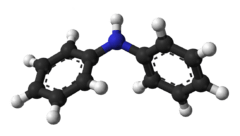Diphenylamine facts for kids
Diphenylamine is a special kind of organic compound (a chemical made mostly of carbon and hydrogen). Its chemical formula is (C6H5)2NH. This means it has two groups of atoms called "phenyl groups" connected to a nitrogen atom.
This compound is related to aniline, another common chemical. Pure diphenylamine is a clear solid, but you might see it looking yellow. This happens because of small amounts of other chemicals that form when it's exposed to air.
Diphenylamine can easily dissolve in many common liquids used in chemistry. It doesn't dissolve very well in water. It's mainly used because it helps stop things from breaking down due to oxygen, like a protector. This is called being an antioxidant.
It's used in many ways, like in factories to prevent damage from oxygen. It also helps dyes stick to materials and is used in farming to fight against fungi and certain worms.
Quick facts for kids Diphenylamine |
|
|---|---|
 |
|
 |
|
|
Preferred IUPAC name
N-Phenylaniline
|
|
| Other names | (Diphenyl)amine Diphenylamine (deprecated) Diphenylazane N-Phenylbenzenamine Anilinobenzene (Phenylamino)benzene N,N-Diphenylamine C.I. 10355 Phenylbenzenamine |
| Identifiers | |
| Abbreviations | DPA |
| CAS number | |
| PubChem | |
| KEGG | C11016 |
| ChEBI | CHEBI:4640 |
| RTECS number | JJ7800000 |
| SMILES | c1ccc(cc1)Nc2ccccc2 |
|
InChI
InChI=1/C12H11N/c1-3-7-11(8-4-1)13-12-9-5-2-6-10-12/h1-10,13H
|
|
| Beilstein Reference | 508755 |
| Gmelin Reference | 67833 |
| Properties | |
| Molecular formula | |
| Molar mass | 0 g mol-1 |
| Appearance | White, off-white |
| Odor | Floral |
| Density | 1.2 g/cm3 |
| Melting point | |
| Boiling point | |
| 0.03% | |
| Vapor pressure | 1 mmHg (108°C) |
| Acidity (pKa) | 0.79 |
| -109.7·10−6 cm3/mol | |
| Hazards | |
| Main hazards | This chemical can be harmful if it touches your skin, is swallowed, or breathed in. It might also irritate your eyes. |
| NFPA 704 |
|
| Except where noted otherwise, data are given for materials in their standard state (at 25 °C, 100 kPa) | |
Contents
How Diphenylamine is Made and How it Reacts
Diphenylamine is made by heating aniline (another chemical) with a special helper called a catalyst. This process removes ammonia (NH3) and leaves diphenylamine.
- 2 C6H5NH2 → (C6H5)2NH + NH3
It's a weak base, which means it doesn't easily accept hydrogen ions. But when it mixes with strong acids, it can form new compounds called salts. For example, with sulfuric acid, it forms a white or yellowish powder.
Diphenylamine can also react in interesting ways to form ring-shaped molecules. For example, if you mix it with sulfur, it can create phenothiazine. This chemical is used to make some medicines.
- (C6H5)2NH + 2 S → S(C6H4)2NH + H2S
It can also react with iodine to form carbazole, releasing hydrogen iodide.
- (C6H5)2NH + I2 → (C6H4)2NH + 2 HI
What Diphenylamine is Used For
Protecting Apples from Scald
Diphenylamine is used to stop apples from getting "scald." Scald is when apples get brown spots on their skin after being stored in cold places. Farmers can spray apples with diphenylamine before or after they are picked.
It works because it's an antioxidant. This means it protects the apple's skin from damage caused by oxygen. This damage usually happens to a natural chemical in apples called alpha-farnesene during storage.
Stabilizer in Gunpowder
In factories that make smokeless powder (used in guns), diphenylamine is added as a "stabilizer." This means it helps keep the powder from breaking down too quickly.
When smokeless powder breaks down, it can release harmful gases. Diphenylamine helps by grabbing onto these gases, stopping them from causing more breakdown.
Antioxidant in Other Products
Diphenylamine is also used as an antioxidant in other products. For example, some types of diphenylamine are added to lubricants (oils that make machines run smoothly). This helps the lubricants last longer.
It's also used in making rubber products. It helps protect rubber from damage caused by ozone, which is a type of oxygen.
Chemical Indicator
Some chemicals that are similar to diphenylamine are used as "redox indicators." These are special chemicals that change color when a chemical reaction happens. They are very useful in chemistry experiments to see when a reaction is complete.
For example, in a test for nitrates, diphenylamine changes to a blue color when nitrates are present.
Making Dyes
Many colorful azo dyes, like Metanil Yellow and Disperse Orange 1, are made using chemicals that come from diphenylamine.
History of Diphenylamine
Diphenylamine was first found in 1864 by A. W. Hofmann. He found it while studying what happened when aniline dyes were heated. Two years later, a group of French chemists made it on purpose. They did this by removing a chemical group from a mixture of aniline and its salts.
Safety and the Environment
Diphenylamine can be harmful if it gets into the body. Studies show it can affect red blood cells and might cause problems with the spleen, liver, and kidneys if someone is exposed for a long time. It can also irritate the eyes.
Scientists have set safe limits for how much diphenylamine people can be exposed to. These limits help protect workers and consumers.
When apples are treated with diphenylamine, some of it can get into the fruit. Scientists study how much stays in the apple and what happens to it over time.
Diphenylamine is not very harmful to birds. However, it can be very harmful to living things in water, like fish.
Rules and Regulations
Europe
In Europe, rules were made in 2005 about how much diphenylamine can be in food. Later, in 2009, the European Commission decided to stop allowing plant protection products (like those used on apples) that contain diphenylamine. This was because there wasn't enough information about its safety for people.
Even after more studies were done, the concerns about safety remained. So, in 2013, it became law in Europe that these products could not be used.
United States
In the United States, the EPA set a limit for how much diphenylamine can be in apples. This limit is 10 parts per million (ppm). For meat and milk, the limit was set very low, at 0.01 ppm.
The EPA reviewed diphenylamine in 1997 and decided that the amounts allowed were safe. They have not reviewed it since then.
See also
 In Spanish: Difenilamina para niños
In Spanish: Difenilamina para niños


